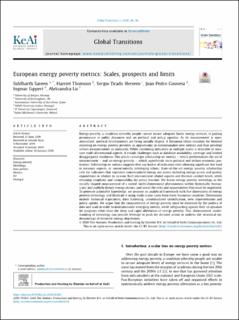| dc.description.abstract | Energy poverty, a condition whereby people cannot secure adequate home energy services, is gaining prominence in public discourse and on political and policy agendas. As its measurement is operationalised, metrical developments are being socially shaped. A European Union mandate for biennial reporting on energy poverty presents an opportunity to institutionalise new metrics and thus privilege certain measurements as standards. While combining indicators at multiple scales is desirable to measure multi-dimensional aspects, it entails challenges such as database availability, coverage and limited disaggregated resolution. This article converges scholarship on metrics – which problematises the act of measurement – and on energy poverty – which apprehends socio-political and techno-economic particulars. Scholarship on metrics suggests that any basket of indicators risks silencing significant but hard to measure aspects, or unwarrantedly privileging others. State-of-the-art energy poverty scholarship calls for indicators that represent contextualised energy use issues, including energy access and quality, expenditure in relation to income, built environment related aspects and thermal comfort levels, while retaining simplicity and comparability for policy traction. We frame energy poverty metrology as the socially shaped measurement of a varied, multi-dimensional phenomenon within historically bureaucratic and publicly distant energy sectors, and assess the risks and opportunities that must be negotiated. To generate actionable knowledge, we propose an analytical framework with five dimensions of energy poverty metrology, and illustrate it using multi-scalar cases from three European countries. Dimensions include historical trajectories, data flattening, contextualised identification, new representation and policy uptake. We argue that the measurement of energy poverty must be informed by the politics of data and scale in order to institutionalise emerging metrics, while safeguarding against their co-optation for purposes other than the deep and rapid alleviation of energy poverty. This ‘dimensioned’ understanding of metrology can provide leverage to push for decisive action to address the structural underpinnings of domestic energy deprivation. | en_US |

